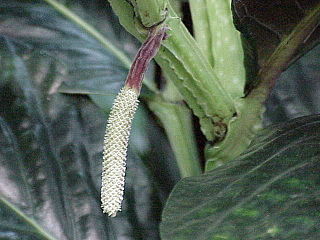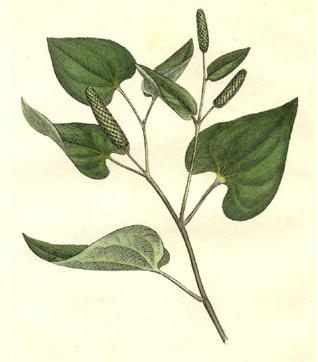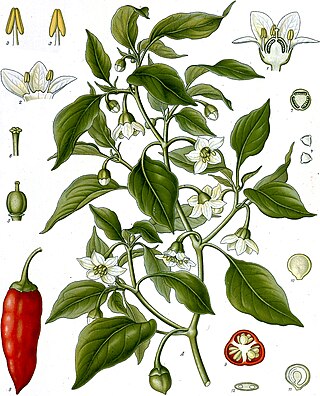
Piper, the pepper plants or pepper vines, is an economically and ecologically important genus in the family Piperaceae.

Chili peppers, also spelled chile or chilli, are varieties of the berry-fruit of plants from the genus Capsicum, which are members of the nightshade family Solanaceae, cultivated for their pungency. Chili peppers are widely used in many cuisines as a spice to add "heat" to dishes. Capsaicin and related compounds known as capsaicinoids are the substances that give chili peppers their intensity when ingested or applied topically. Chili peppers exhibit a wide range of heat and flavors. This diversity is the reason behind the availability of different types of paprika and chili powder, each offering its own distinctive taste and heat level.

Black pepper is a flowering vine in the family Piperaceae, cultivated for its fruit, which is usually dried and used as a spice and seasoning. The fruit is a drupe (stonefruit) which is about 5 mm (0.20 in) in diameter, dark red, and contains a stone which encloses a single pepper seed. Peppercorns and the ground pepper derived from them may be described simply as pepper, or more precisely as black pepper, green pepper, or white pepper.

The Piperaceae, also known as the pepper family, are a large family of flowering plants. The group contains roughly 3,600 currently accepted species in 5 genera. The vast majority of species can be found within the two main genera: Piper and Peperomia.

Piperine, possibly along with its isomer chavicine, is the compound responsible for the pungency of black pepper and long pepper. It has been used in some forms of traditional medicine.

Piper cubeba, cubeb or tailed pepper is a plant in genus Piper, cultivated for its fruit and essential oil. It is mostly grown in Java and Sumatra, hence sometimes called Java pepper. The fruits are gathered before they are ripe, and carefully dried. Commercial cubeb consists of the dried berries, similar in appearance to black pepper, but with stalks attached – the "tails" in "tailed pepper". The dried pericarp is wrinkled, and its color ranges from grayish brown to black. The seed is hard, white and oily. The odor of cubeb is described as agreeable and aromatic and the taste as pungent, acrid, slightly bitter and persistent. It has been described as tasting like allspice, or like a cross between allspice and black pepper.

Long pepper, sometimes called Indian long pepper or pippali, is a flowering vine in the family Piperaceae, cultivated for its fruit, which is usually dried and used as a spice and seasoning. Long pepper has a taste similar to, but sweeter and less pungent than, that of its close relative Piper nigrum – from which black, green and white pepper are obtained.

"Peter Piper" is an English-language nursery rhyme and well-known alliteration tongue-twister. It has a Roud Folk Song Index number of 19745.

The peppered catshark is a common but little-known species of catshark, part of the family Scyliorhinidae, inhabiting depths of 130–1,326 m (427–4,350 ft) in the northern Gulf of California. It is found on or near the ocean floor, and conducts seasonal migrations, spending winter in deeper water. Reaching a length of 37 cm (15 in), this species has a slender grayish body with a fine covering of black dots. On the dorsal edge of its caudal fin is a prominent crest of enlarged dermal denticles. It is oviparous, with the reproductive period probably lasting from May to September. The International Union for Conservation of Nature (IUCN) has listed the peppered catshark under Least Concern, as it faces no significant threats from human activity.

Piper auritum is an aromatic culinary herb in the pepper family Piperaceae, which grows in tropical Central America. Common names include hoja santa, yerba santa, hierba santa, Mexican pepperleaf, acuyo, tlanepa, anisillo, root beer plant, Vera Cruz pepper and sacred pepper.

Schinus molle is an evergreen tree that grows to 15 meters. It is native to an area from the Peruvian Andes to southern Brazil. The bright pink fruits of Schinus molle are often sold as "pink peppercorns" although S. molle is unrelated to black pepper. The word molle in Schinus molle comes from mulli, the Quechua word for the tree. The tree is host to the pepper-tree moth, Bombycomorpha bifascia.

Piper aduncum, the spiked pepper, matico, hierba del soldado, achotlín, cordoncillo, higuillo or higuillo de hoja menuda, is a flowering plant in the family Piperaceae. Like many species in the family, the matico tree has a peppery odor. It grows wild on the coasts and in the forests of Central and South America and in the Interandean Valleys, up to 3,000 m (9,800 ft) above sea level.

Piper guineense is a West African species of Piper; the spice derived from its dried fruit is known as Ashanti pepper, Benin pepper, Edo pepper, false cubeb, Guinea cubeb, and called locally kale, kukauabe, masoro, etiñkeni, sasema, soro wisa, eyendo, eshasha by the Urhobo people, and oziza and uziza by the Igbo people of Nigeria. It is a close relative of cubeb pepper and a relative of black pepper and long pepper. Unlike cubeb, which is large and spherical in shape, Ashanti pepper grains are prolate spheroids, smaller and smoother than Cubeb pepper in appearance and generally bear a reddish tinge. The stalks of Ashanti pepper berries are also distinctly curved whilst those of cubeb pepper are completely straight. The terms West African pepper and Guinea pepper have also been used, but are ambiguous and may refer to grains of Selim or grains of paradise.

Or Lam is a mildly spicy, slightly tongue numbing, Laotian stew originating from Luang Prabang, Laos. The peppery and thick broth is prepared by slowly simmering lemongrass, chilies and Lao chili wood (sakhaan) with crushed or mashed up sticky rice, grilled citronella, garlic, dill and onions added to thicken the broth.

Piper retrofractum, the Balinese long pepper or Javanese long pepper, is a flowering vine in the family Piperaceae, cultivated for its fruit, which is usually dried and used as a spice and seasoning. The fruit of Piper retrofractum is similar in appearance and taste to that of the Indian long pepper.

Piper chaba, commonly known as piper chilli, is a flowering vine in the family Piperaceae native to South and Southeast Asia. P. chaba is called chui jhal or choi jhal in the Khulna Division of Bangladesh, and the states of Tripura and West Bengal in India. P. chaba is found throughout India, and other warmer regions of Asia including Malaysia, Indonesia, Singapore and Sri Lanka.

Piper borbonense is a species of plant in the genus Piper. A close relative of black pepper, its berries are used as a spice known as voatsiperifery, which comes from voa, the Malagasy word for fruit, and tsiperifery, the local name of the plant. A wild pepper, it grows in Madagascar. It can reach up to 20 metres and needs a natural plant support.

The cayenne pepper is a type of Capsicum annuum. It is usually a moderately hot chili pepper used to flavor dishes. Cayenne peppers are a group of tapering, 10 to 25 cm long, generally skinny, mostly red-colored peppers, often with a curved tip and somewhat rippled skin, which hang from the bush as opposed to growing upright. Most varieties are generally rated at 30,000 to 50,000 Scoville units.
Guineesine is a compound isolated from long pepper and black pepper.

















